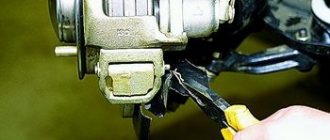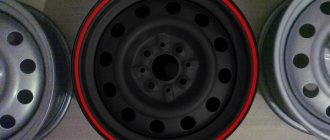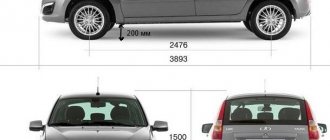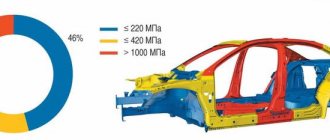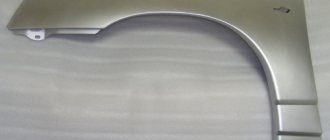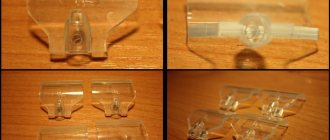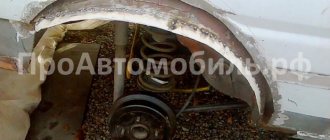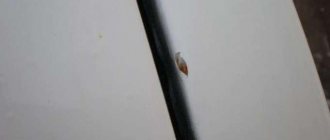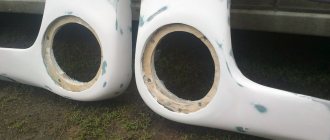Helpful information
The thickness of a car's paintwork when painted at the factory.
Depending on the car model and the factory batch, the thickness of the factory coating of body parts can range from 70 to 150 microns . For example, let's look at the following table.
Table of thicknesses of factory coating of cars:
| car model | Automobile model | Paint thickness (µm) |
| Audi A5, Audi A6 Audi A7 Audi A8 Audi Q3, Audi Q5 Audi Q7 | up to 100 155 — 170 100 — 115 135 — 140 115 — 145 | |
| BMW X1 BMW X3, BMW M6 BMW X5, BMW X6 BMW 5er (E60) | 110 90 — 100 120 — 165 130 — 165 | |
| BYD F3 | up to 100 | |
| Citroen C3 Citroen C4 Citroen C4 (2011) Citroen C5 Citroen C-Crosser | 90 — 120 75 — 125 90 — 135 110 — 130 55 — 90 | |
| Chery Amulet Chery Tiggo | 110 — 120 100 — 110 | |
| Chevrolet Aveo Chevrolet Captiva Chevrolet Cruze Chevrolet Epica Chevrolet Lacetti Chevrolet Lanos Chevrolet Niva Chevrolet Spark | 70 — 80 85 — 95 120 — 130 95 — 105 110 — 140 85 — 150 90 — 100 90 — 100 | |
| Daewoo Nexia Daewoo Matiz | 95 — 115 100 — 120 | |
| Fiat Albea Fiat Punto | 115 — 130 110 — 120 | |
| Ford Explorer Ford Focus Ford Kuga Ford Mondeo | 140 — 150 155 — 160 130 — 140 120 — 130 | |
| Geely Albea Geely MK Geely Otaka Geely Punto | 80 — 100 80 — 100 75 — 80 75 — 80 | |
| Honda Accord Honda Accord 7 Honda Civic Honda CR-V Honda Fit | 90 — 100 130 — 145 100 — 110 80 — 90 90 — 100 | |
| Hyundai Accent Hyundai Elantra Hyundai IX Hyundai Santa Fe Hyundai Solaris Hyundai Sonata Hyundai I30 Hyundai I40 | 70 — 75 75 — 95 70 — 80 80 — 95 95 — 105 80 — 90 100 — 110 100 — 110 | |
| Infiniti FX35 | 110 — 120 | |
| Kia Cee'd Kia Cerato Kia Optima Kia Picanto Kia Rio Kia Sorento Kia Soul Kia Sportage Kia Venga | 100 — 110 110 — 120 120 — 130 110 — 120 100 — 110 95 — 105 105 — 115 110 — 120 120 — 130 | |
| Lada Kalina Lada Priora Lada Granta | 60 — 90 70 — 100 90 — 100 | |
| Lexus RX Lexus CT Lexus GX Lexus ES Lexus LX Lexus LS | 140 — 150 130 — 140 120 — 130 135 — 145 140 — 150 145 — 155 | |
| Mazda CX-5 Mazda CX-7 Mazda 3 Mazda 6 | 90 — 100 85 — 120 110 — 130 110 — 120 | |
| Mercedes-Benz C Mercedes-Benz E Mercedes-Benz GL Mercedes-Benz ML | 90 — 100 90 — 100 90 — 100 90 — 100 | |
| Mitsubishi ASX Mitsubishi Lancer Mitsubishi L200 Mitsubishi Outlander XL Mitsubishi Pajero | 70 — 80 90 — 125 55 — 70 50 — 75 100 — 110 | |
| Nissan Almera Nissan Juke Nissan Murano Nissan Navara Nissan Pathfinder Nissan Patrol Nissan Qashqai Nissan Tiida Nissan Teana Nissan X-Trail | 140 — 150 120 — 130 90 — 100 105 — 115 100 — 110 75 — 85 110 — 120 100 — 110 125 — 135 80 — 90 | |
| Peugeot 308 Peugeot 508 Peugeot 3008 Peugeot 4008 Peugeot Occasions | 110 — 120 100 — 110 105 — 115 60 — 70 90 — 100 | |
| Opel Astra Opel Astra GTC Opel Astra Turbo Opel Corsa Opel Zafira | 125 — 160 105 — 115 125 — 140 115 — 125 115 — 125 | |
| Renault Duster Renault Fluence Renault Koleos Renault Logan Renault Megane Renault Sandero | 110 — 120 100 — 140 90 — 100 70 — 120 120 — 130 105 — 115 | |
| Skoda Fabia Skoda Octavia Skoda Roomster Skoda Superb Skoda Yeti | 105 — 115 120 — 130 120 — 130 95 — 105 110 — 120 | |
| Subaru Impreza Subaru Forester Subaru Legacy Subaru Outback Subaru Tribeca | 120 — 130 110 — 120 105 — 115 130 — 140 115 — 125 | |
| Suzuki Grand Vitara Suzuki Splash Suzuki SX4 Suzuki Swift | 75 — 95 90 — 100 110 — 120 100 — 110 | |
| SsangYong Kyron | 100 — 110 | |
| Toyota Auris Toyota Avensis Toyota Camry Toyota Corolla Toyota Highlander Toyota LC 200 Toyota LC Prado Toyota Prius Toyota Rav4 Toyota Verso | 105 — 115 80 — 120 110 — 125 100 — 110 90 — 100 110 — 130 75 — 95 80 — 90 80 — 90 105 — 115 | |
| Volkswagen Polo Volkswagen Golf Volkswagen Jetta Volkswagen Touareg Volkswagen Tiguan | 100 — 110 90 — 100 75 — 85 70 — 80 80 — 90 | |
| Volvo S80 Volvo C30 Volvo XC60 Volvo XC70 Volvo XC90 Volvo S60 Volvo S60 II | 105 — 140 105 — 140 115 — 130 105 — 140 115 — 135 110 — 130 95 — 115 | |
| GAZ Siber GAZ-3110 | 90 — 105 75 — 85 |
As can be seen from the table, the thickness of the coating even for cars of the same brand varies and depends on the batch, year of manufacture, etc. You also need to keep in mind that the thickness of paint on horizontal and vertical surfaces may differ. More precisely, the paint on the door may be thinner than on the hood. This is normal, this happens because the paint runs off after application.
How to use a thickness gauge?
The measuring instruments, which are shaped like a gun, are very easy to use. You just need to press switched-on device firmly against a metal surface, and then press and release the trigger. Numbers will appear on the display that show the distance from the device sensor to the metal, i.e. the thickness of the paint coating applied to the metal. Based on this thickness, you can easily identify repainted body parts and, accordingly, identify a damaged car. It is necessary to take several measurements on each part of the car body.
Features of the paint layer at the factory - thickness and composition
Not all potential car buyers on the free market understand why there is such a stir around paintwork. Many brands of modern cars even indicate the exact thickness of the paintwork in the car documents. When choosing a used car with the right approach, it is necessary to examine the paintwork layer to check for its thickening in certain places. The thing is that the values from the table are of great importance for some reasons:
- Only high-quality components are used in the factory layer of paints and varnishes;
- the guarantee of the absence of putty gives hope for a long service life of metal body parts;
- with any car body repair, the quality of the paint will no longer be the same as it was at the factory;
- even budget brands try to do the painting as efficiently as possible to protect all parts;
- if the thickness of the paint layer is too small or too high, problems in car operation are guaranteed.
This is why you need a thickness table, which will help you find out the original parameters for each model. But the thickness of paint on cars must be assessed qualitatively. For this purpose, special equipment called a paint thickness gauge is used. With such a simple feature, you can examine the entire car and draw conclusions on the condition of the paintwork. To conduct such research, you do not need to be an expert in the field of auto enamel and painting processes.
How to determine damage using a thickness gauge?
It will not be difficult to conduct research on any brand of car using such a tool. You will need the original paint thickness on the car, which can be found in the table. Write down or remember this value. Then use the device to determine the paintwork indicators on all parts of the car. This procedure is carried out in a few minutes and does not require any special skills. But it is important to do everything accurately and without doubt.
The only caveat worth remembering here is the quality of the device. Sometimes the data from the table will not agree completely because the thickness gauge can be a little deceiving. If the deviation is within 10-15%, you can ignore such moments. But exceeding the permissible values by several times is a guarantee of poor-quality body repairs to the car. Most often, paintwork in such places can be visually distinguished from factory coatings.
The thickness of the paintwork! What it should be.
All thickness gauges have a 2 year warranty. As a gift, a table of factory paint thickness on different cars. All thickness gauges undergo mandatory Toyota Allion paint thickness and calibration before shipping.
Next, measure the racks - their upper parts can be used as a guide. The front and rear of the body are areas that are repaired very often. You should also pay attention to the front doors and sills. Then measurements are taken in all external segments. Don't forget about the internal cavities - the space under the hood, trunk, interior, gas tank hatch.
Thickness of car paintwork. Table.
First of all, measure the parts separately. Suspicious areas are measured once - in the center and along the edges.
The differences should not be more than 35 microns. Then the arithmetic average is calculated and the total thickness of the paint layer for the entire car is determined. Table of paint thicknesses The table below shows the thickness indicators on different cars. It must be remembered that these are approximate figures obtained empirically. Manufacturers themselves cannot accurately answer how thick the paint is on a car that has just left the factory.
Japanese and Korean cars, for example, Toyota paintwork thickness Toyota Allion Kia Rio, are painted so that the thickness is within microns.
What is a thickness gauge
A thickness gauge is a device for measuring the thickness of a paint coating. Looks like a small box.
There are many models of thickness gauges on the market, just like smartphones.
Some thickness gauges work at temperatures below zero, others do not. Some models measure aluminum parts, others only work on steel surfaces.
I recommend using professional thickness gauges - these are, for example, models Etari ET111, Etari ET11p, Autotest 112. You can buy one for 5000-7000 rubles.
But if you change your car every three years or less often and don’t plan to use a thickness gauge often, then there’s no point in buying one. You can just rent. It costs from 300 to 500 rubles per day.
Hundreds of thickness gauges are rented out on Avito
What thickness of paint should be on a car?
It was removed without applying a layer of putty by polishing. Accordingly, the thickness of the coating decreased. What are the specific numbers? We can definitely say that the thickness of the Toyota paint layer of a car has changed if: Table of factory indicators of paintwork thickness for different brands of cars Procedure for examining the thickness of the paint layer We recommend performing this work on cars in the following volume: Start taking measurements from the roof.
It is one of the main components of the body.
If everything is fine here, continue. Check the thickness of the coating on the posts.
Paintwork thickness table
You need to know the thickness of the factory coating and compare it with the value obtained when measured with a thickness gauge. Depending on the thickness of the Toyota Harrier paintwork there will be a difference, and whether it is more or less than the factory one, we can conclude whether the car has been repainted. At the end of the article there is a table of factory paint layer thickness values for some brands of cars from different manufacturers.
Analysis of the thickness of the paint layer applied at factories may vary slightly depending on the year of the paintwork thickness of a Toyota Harrier car of the same brand. In addition, the thickness may also be different on different body parts. In one case or another, on average, the size of the paint layer on most modern cars should not exceed the limits of: Do-it-yourself chrome plating of disks Checking the thickness of the paint on the hood of the car The thickness gauge used for measurements shows the value of the paint layer size.
This is the value from its top point of the layer to the surface of the metal of the body part on which the measurement is made. It follows that the device will take into account the thickness of the putty, if it is there. These readings will always be higher than the factory readings.
This result indicates that the car was previously damaged, underwent repairs and subsequent painting. There are cases when measurements on car bodies reveal the thickness of the paint layer to be less than the factory value. This means that there was probably minor local damage at the thickness of the Toyota Harrier paintwork.
It was removed without applying a layer of putty by polishing. Accordingly, the thickness of the coating decreased.
What should be the thickness of paintwork on cars - table and explanations
Classification of thickness gauges In specialized stores they offer the thickness of Toyota Harrier paintwork types of such devices. It goes without saying that the principle of their operation, cost and capabilities are different. Therefore, it makes sense to consider each type separately: Ultrasonic - work with both metal materials and plastic, composites and ceramics.
This makes it possible to measure the thickness of paintwork on the bodies of any car brands, not only on metal surfaces, but also on decorative elements. The main disadvantage is the high price; the cost of an entry-level product starts from 10 rubles.
Eddy current - the sensor evaluates the condition of the coating on any metal with high accuracy. However, the result depends on the conductivity of the part.
Thus, when studying copper and aluminum, the assessment will be as accurate as possible, but on iron, errors already appear. The cost of an eddy current thickness gauge is around 5 rubles.
Electromagnetic - reliable and practical devices that give fairly accurate results. Their price does not exceed 3 rubles, but there are also disadvantages: Magnetic - the functionality is based on the principle of a magnet; the more it is attracted to the body, the more the needle deviates.
Is the paint thickness of 200 microns on the 2014 handicap normal?
Accordingly, a smaller angle of inclination indicates a thick layer of coating, which is alarming. Despite the low price in rubles and ease of operation, the unit is capable of accurately assessing the surface only with a thickness not exceeding 1.5 mm.
How to use a thickness gauge correctly? When purchasing a car on the secondary market, it is not enough to know how the purchase and sale transaction and vehicle registration take place.
How to check a car with a paintwork thickness gauge: instructions
To use a thickness gauge correctly, it is important to know that a new device must be calibrated. Even if the store seller swore that the device is completely ready for use, it is important to check the accuracy of its readings. For this purpose, so-called reference plates made of metal and plastic are used. Each of them is coated with a layer of paint of a certain thickness. If the instrument readings do not match the data indicated on the reference plate, the necessary changes are made to the settings. Next, we’ll look at how to use a car paint thickness gauge.
You can determine whether a car has been in an accident and how serious the accident was by checking the thickness of the paintwork on various body elements. Experts advise starting the check from the front fender and then moving along the perimeter of the car, carefully recording all indicators. To obtain the most accurate results, it is best to check each element three times, and then calculate the arithmetic mean.
When factory painted, the thickness of the paint coating varies from 90 to 160 microns (0.09-0.16 mm). This indicator may differ for different car models. For example, in the Volkswagen Jetta it is 0.12-0.15 mm, and in the Mazda 3 it is 0.08-0.1 mm. The permissible difference between the upper and lower values should not exceed 0.03-0.04 mm.
If, as a result of the inspection, it turns out that the paint layer on one or more body elements is more than required, most likely the car was in an accident and was repainted. Buying damaged cars should be done with caution. By the degree of deviation from the norm, one can judge how serious the damage to the body was. In particular:
- If, during inspection, the maximum value on any body element (fender, hood, etc.) is exceeded by 50 microns, there is no particular reason to worry: most likely, we are talking about repairing a small scratch (after restoration, the surface of the element is covered with varnish, which and increases the paint layer by 0.05 mm). You can safely buy such a damaged car;
- if the check indicates that the norm is exceeded by 300-500 microns, it’s time to think: perhaps the car was in a fairly serious accident, after which some body elements required straightening and putty;
- indicators exceeding the average value by 1000 or more microns indicate that the accident was very serious. Some parts needed replacing, but the seller decided to save money and apply a large layer of putty. In the future, this can lead to cracks in the paintwork and many other problems. It is better not to buy such damaged cars.
Checking a car with a thickness gauge is a slow process and requires attention. If you are not sure that you can properly check the car yourself, invite an experienced specialist. You need to understand that it is better to spend a relatively small amount of money and a couple of hours of your time checking the car before purchasing than to throw away several tens, or even hundreds of thousands of rubles.
A simpler and cheaper way to check a car for involvement in an accident is offered by Autocode. To find out the car history, just indicate the car number. Within 5 minutes, the system will display all the information about the car: number of owners, mileage, participation in accidents, calculation of insurance repairs , restrictions and fines, and much more. Check your car online in one click!
After learning the full history of the car, get to know its technical condition better. If you do not have the opportunity to personally attend the car inspection, or you doubt your knowledge, order an Autocode on-site inspection. The technician arrives as soon as possible and checks the car with a specialist. instruments and gives an accurate conclusion.
Paintwork thickness and how to analyze it
During the operation of vehicles, their painting can be carried out entirely or partially in local repaired areas. The paint thickness of the body as a whole or of its individual element will always differ from the factory value. You need to know the thickness of the factory coating and compare it with the value obtained when measured with a thickness gauge. Depending on what the difference will be and in what direction (more or less from the factory), we can conclude whether the car was repainted.
At the end of the article there is a table of factory paint layer thickness values for some brands of cars from different manufacturers.
Analysis of the thickness of the paint layer applied at factories may vary slightly depending on the year of manufacture of a car of the same brand. In addition, the thickness may also be different on different body parts . In one case or another, on average, the size of the paint layer on most modern cars should not exceed the following limits:
- minimum - 75 microns;
- maximum - 165 microns.
Checking the thickness of the paint on the hood of a car
The thickness gauge used for measurements shows the value of the paint layer. This is the value from its top point of the layer to the surface of the metal of the body part on which the measurement is made. It follows that the device will take into account the thickness of the putty, if it is there . These readings will always be higher than the factory readings. This result indicates that the car was previously damaged, underwent repairs and subsequent painting.
There are cases when measurements on car bodies reveal the thickness of the paint layer to be less than the factory value. This means that there was likely minor local damage at this location. It was removed without applying a layer of putty by polishing. Accordingly, the thickness of the coating decreased.
How to calibrate a thickness gauge
To give accurate results, the thickness gauge must be calibrated. Calibration gets lost due to temperature changes or if the battery runs out.
To calibrate the thickness gauge, metal plates are used, which are sold with it. If you rent an instrument, ask the owner to calibrate it in front of you and provide you with rental calibration plates just in case.
The calibration plates look like this:
My thickness gauge has two gauge plates because it works on both steel and aluminum parts. The device must be calibrated separately for steel and aluminum. If the thickness gauge only works on one metal, there will be one plate.
The kit usually includes a special calibration film, which is used for adjustment.
The calibration process is simple - place the thickness gauge on the plate and reset the readings to zero:
We apply the calibration film to the plate and place the device on top:
The thickness gauge should show the numbers printed on the film. If this does not happen, repeat the procedure.
What thickness of paint should be on a car? Table with values and verification technology.
Anyone who has dealt with buying a used car knows that when inspecting a vehicle, they often first of all look at the paintwork, which can tell a lot about the car itself, and then a decision is made to look at its technical part or not. In addition to the visual inspection, the buyer is interested in how thick the paint is on the car and, if there are problem areas, how much they exceed the values of the original paint from the factory. Why is this so important? Such information will help you find out whether the car was in an accident, or whether there were problems with body corrosion, whether putty was used, and what important elements of the body structure might have broken geometry. All these parameters affect the performance of the machine in the future and, of course, the price that the seller asks for it. For example, if you see that the paint thickness on the car pillars has increased significantly, then there may have been a serious accident and you will not want to take such a vehicle for your family, because safety comes first.
How does the measurement happen?
Usually, for these purposes, they buy or rent a device for measuring the thickness of paint on a car.
They come in various modifications and prices, so you will definitely find what you can use to measure this parameter during inspection. In practice, the measurement process looks like this: You will need to place the measuring surface of the device as tightly as possible against the car body and press the button. After which a value will appear on the screen that measures the distance from the device to the metal of the body, thus showing the thickness of the paint layer. If there is putty on the part, it will also be included in the general layer.
In practice, repainted or restored paintwork shows the following parameters:
- Increasing the layer thickness by 2 or more times. For example, if there is putty, values of 800 – 900 microns may appear.
- You can determine exactly the point where the main damage occurred by assessing the differences in the obtained indicators. The thickness of a car's factory paint usually ranges from 10 to 40 microns, and the repainted surface shows values significantly exceeding these values.
Analysis of paint thickness
You know that repairing the paint layer of a car can be of two options: complete and partial. It is the local repainted areas that often come up when checking a car, and hence either bargaining or refusal of further inspection. As a basis, you always take the factory indicator that is applied to new cars, and see how much it exceeds or falls below the value you received on the device screen.
If we talk about the factory technology for applying paintwork, it is also not ideal and the thickness of the paintwork layer can vary depending on the brand and year of manufacture of the same manufacturer model.
Among craftsmen, it is believed that the thickness of factory paint should be in the range of 75 - 165 microns.
And if everything is crystal clear with additional layers of material, then what to do if the device shows a value less than the minimum mark? This also happens because it is a consequence of polishing the body or its individual elements. During this procedure, abrasive pastes remove part of the coating layer and the thickness becomes smaller.
What the thickness gauge will show
Using a thickness gauge is simple: take a calibrated device and apply it to the car body at a right angle. It will immediately show the coating thickness in micrometers. One micrometer is one thousandth of a millimeter.
I applied the thickness gauge to the body of my car. Coating thickness - 117 microns. Everything is fine, my car was not painted (I already knew this, but for your use as an example)
The higher the value the thickness gauge shows, the larger the paint layer and the higher the likelihood that this car was repaired after an accident. Typically, the factory paint layer on steel parts of a car is no more than 200 microns.
Readings above 200 microns indicate repainting.
Readings of up to 300 microns occur if a cosmetic defect has been painted over on the car, for example a scratch from a key. This does not affect the safety of passengers in any way, but you can still bargain.
Readings closer to 1000 microns indicate that there is still putty under the paint. A body element with such indications was definitely severely deformed in an accident and was puttied during repairs. If the work is done poorly, the paint on the putty may crack and fall off over time.
More than 1000 microns is a sign of serious body repair, which means participation in a serious accident. It is better not to buy a machine with a coating layer of more than 1000 microns.
2000 microns is the maximum value that the thickness gauge can show. If the layer is thicker, the device will not show numbers. This means that there is a lot of putty at this point.
Check in advance what the factory paint thickness should be on the car model you are going to buy. This information can usually be easily googled using a query like “Mazda 3 paintwork thickness.” A small scatter of readings is acceptable, but not more than 60 microns.
There are comparative tables of normal coating thickness for different cars on the Internet.

